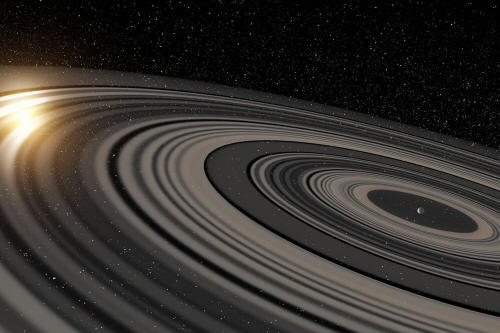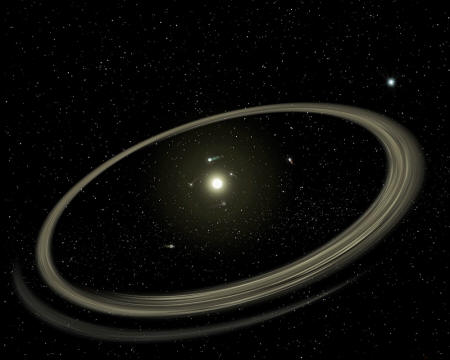|
creating a disk so
wide it took two months to pass in front of its star. A team of U.S. and British astronomers has stumbled on what may be a giant planet with rings 200 times the size of Saturn's. The distant world, known as J1407b and first noticed four years ago, orbits a star located about 430 light-years from Earth - relatively nearby in cosmic terms.
It's probably between ten and 40 times as massive as Jupiter, according to Matthew Kenworthy of the University of Leiden, in the Netherlands, lead author of a paper about the discovery (Modeling Giant Extrasolar Ring Systems in Eclipse and the Case of J1407b - Sculpting by Exomoons?) that will be published in the Astrophysical Journal.
The study reveals new details about the structure of the giant ring system.
As enormous as the planet itself is, giant worlds aren't especially unusual among the 2,000 or so exoplanets confirmed by astronomers so far. But this planet is the first to be suspected of having a ring system like Saturn's - except it's so big that if Saturn's rings were this size, they'd stretch halfway to Jupiter.
The discovery of the giant rings was completely accidental.
In 2011, Mark Pecaut, then a graduate student at the University of Rochester, in New York, was looking at data from the SuperWASP exoplanet search.
He was interested in stars, not planets, but the SuperWASP archive had data on these as well, and in particular on the rotation rates of young stars in a group known as the Scorpius-Centaurus Association.
All of the stars looked unremarkable, except for one.
Pecaut (now at Rockhurst University, in Kansas City, Missouri) noticed an odd waxing and waning of the star's light, says co-author Eric Mamajek of the University of Rochester,
Instead of dimming slightly for a few hours, as would happen if a planet passed in front of the star, this star had flickered for about two months - dimmer for a while, then a little brighter, then dimmer again.
The astronomers realized right away that they might be looking at a system of rings passing in front of the star.
But for the rings' passage to last two months, they would have to be gigantic, much larger than any ever seen before. The team worked hard to see if there could be another explanation - individual clouds of dust dimming the star, for example.
In 2012, after a year of consideration, they announced their find (Planetary Construction Zones in Occultation - Discovery of an Extrasolar Ring System).
Even then, the claim of a giant ring system was audacious. It was met with a lot of raised eyebrows, recalls Mamajek.
The new analysis has eased the skepticism somewhat by nailing down the rings' structure more precisely, and showing how the rings would produce just the pattern of flickering the astronomers saw.
Young Rings in Transition?
The fact that this star and everything associated with it is only 16 million years old, however, compared with the sun's 4.59 billion years, still poses a potential problem.
If the rings are that young, the outer parts should condense into moons relatively soon - the same thing that happened with Saturn in the early history of our own solar system.
It's a remarkable coincidence that astronomers managed to spot it during such a transient phase of its life.
But he does consider the coincidence potentially concerning.
Adding to the uncertainty is the fact that the planet that's presumably nestled at the center of the ring system isn't nearly as easy to see as the rings themselves.
In fact, the astronomers can only deduce its presence. It could be, however, that it's not possible for us to see at this angle.
Kenworthy has created a below animation to show how this would work:
Another problem, the authors acknowledge, is that the ring system, if that's what it is, has passed in front of the star only once.
The signal, says Harvard astronomer David Kipping, is,
But that doesn't mean it's being dismissed. Mamajek, Kenworthy, and their colleagues are monitoring the star carefully in anticipation of that crucial repeat observation.
They've even recruited a group of high-level amateur astronomers, the American Association of Variable Star Observers, to help out.
|


